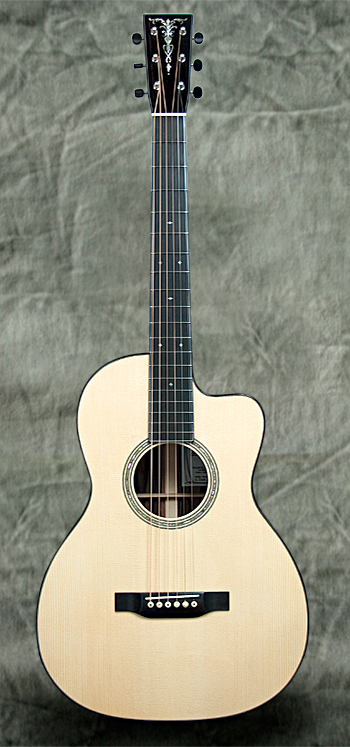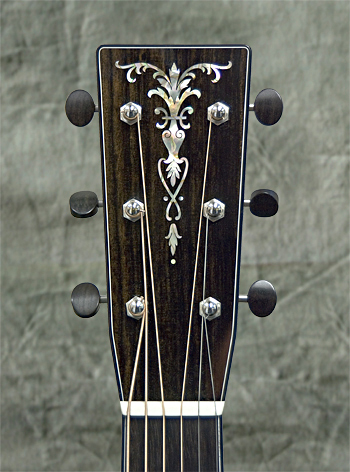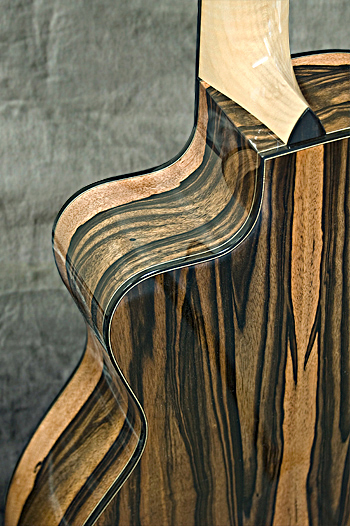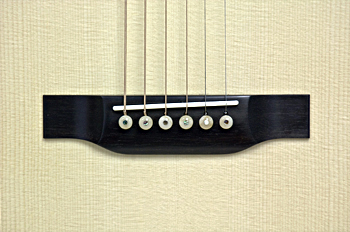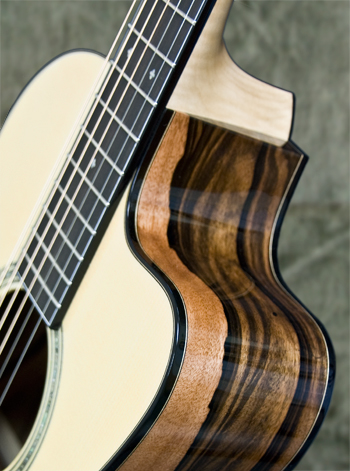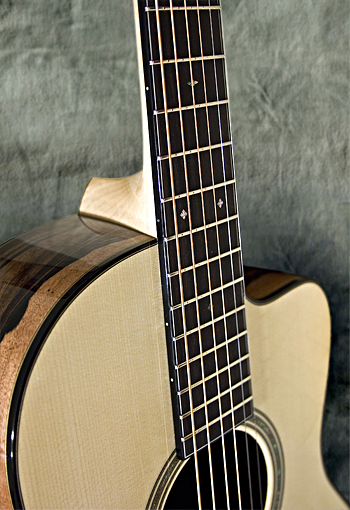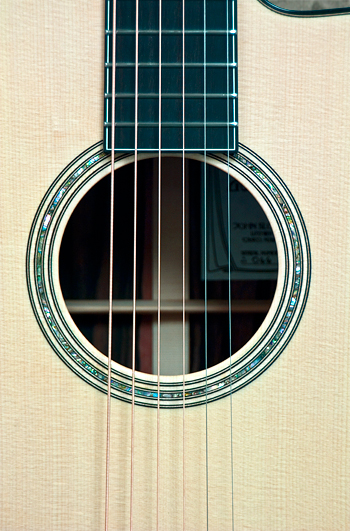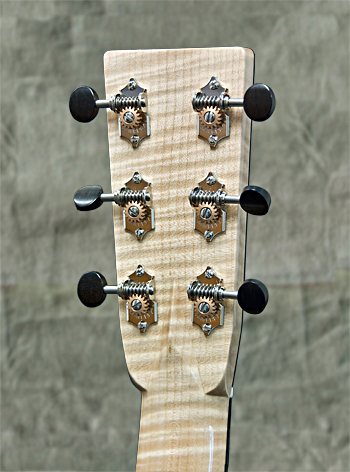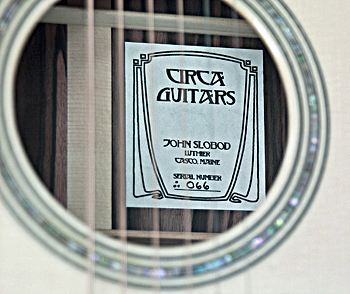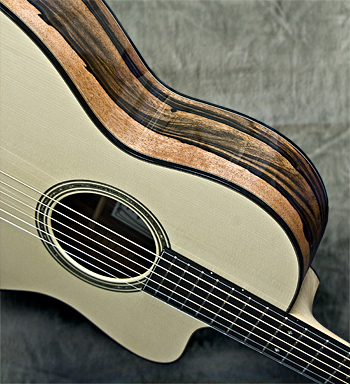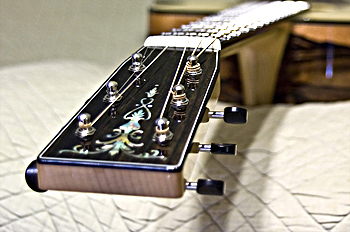2010 Circa 00
(click on images to see larger versions)
– top: Italian spruce (Picea excelsa)
– back & sides: Macassar ebony (Diospyros celebica)
– neck: flamed rock maple (Acer saccharum) w/ adjustable truss rod
– fingerboard: ebony (Diospyros crassiflora)
– bridge: ebony
– bridgepins: bone with mother of pearl dots
– headplate: ebony w/ custom ‘torch’ pearl inlay
– body bindings: ebony with ebony & maple purfling in John’s ‘short binding’
– endgraft: ebony with ebony & maple purfling in John’s ‘short binding’
– fingerboard & headstock binding: black & white plastic
– heelcap: ebony
– nut: bone
– saddle: bone
– tuners: nickel-plated Waverlys w/ ebony buttons
– bridgeplate: rock maple
– rosette: black fiber/maple purfling, green heart abalone; ‘style 42’ pattern
– side fret markers: mother of pearl
– fret markers: mother of pearl in the ‘slotted squares & diamonds’ pattern
– lining: Spanish cedar on top; mahogany on back
– neck- & tailblocks: mahogany w/ an Indian rosewood (Dalbergia latifolia) cap on the neckblock
– frets: stainless steel
– top & back braces: Adirondack spruce (Picea rubens)
– side braces: Indian rosewood
– glue: hide glue
– finish: nitrocellulose lacquer/
DIMENSIONS:
scale length: 25.4″
nut width: 1 25/32″ (1.78″)
string spacing at saddle: 2.25″
weight: 4.0 lbs.
width, upper bout: 10.3″
width, lower bout: 14.25″
depth at neckblock: 3.5
depth at tailblock: 4.15
body length: 19.65″
total length: 39.2″
Circa Guitars
34 Cole Street
South Portland, ME 04106
207.233.5625
A Player’s Review, 8/23/10:
The Inspiration
Around 1980, when I was gigging full-time, I visited George Gruhn’s guitar shop in Nashville where I played a superb Martin 00 from the late 20s – early 30s. In terms of my ‘ideal guitar sound’ (at the time), this little jewel was damn near perfect – and, unfortunately, far beyond the price range of a struggling road musician such as myself. The sound of that guitar haunted my dreams for the next 25 years. Flash-forward to 2006, when I first met John Slobod of Circa Guitars, played his instruments, and thought he might be the guy who could build a do-everything guitar that would satisfy someone as picky as I am. So, I commissioned an OM. After two years of playing the majestic instrument he made for me, I felt like he was up to the task of re-creating and expanding on the vintage vibe of that little 00 that thrilled me so many years ago, so in the summer of 2009 our conversations about it got serious.
The Design
I saw this project as an attempt to update the pre-war fingerstyle sound of those great old small Martins in a contemporary expression of the classic 00 body style. I wasn’t looking for a replica or recreation of a 20’s Martin, rather, a respectful but contemporary re-interpretation of the 00, so, Photoshop jockey that I am, I used photos I had taken of John’s other guitars to make a mockup of my ‘Dream 00,’ sent it to John and said “Make me this”.
Playing a guitar is a rich sensory experience involving Sight, Sound and Touch. A fine instrument should be pleasing to the eye in form and construction, should feel good against the body with a neck and action that make playing easy and enjoyable, and, of course, have a sound that is satisfying to the ear. So here are my evaluations of each of these dimensions for this guitar.
SIGHT:
In keeping with the notion that this would be an ‘updated’ re-imagining of a pre-war 00, I chose a solid headstock instead of a slotted one, and a belly bridge over the ‘pyramid’ style. A cutaway was also a must for me. Visually, I imagined the guitar to present an elegant ‘black & white’ theme, with dark ebony headplate, fingerboard, binding, bridge and tuner buttons, contrasted with a natural spruce top, black & white binding on the fingerboard and headstock, bone nut & saddle, and bone bridgepins, highlighted by pearl inlays on the pins, rosette and fretmarkers, and tied together with a small vintage-style headplate inlay. For the inlay, in homage to the 00’s pre-war Martin heritage, I had always liked Martin’s original 1902 torch design, but found it a little too ‘busy,’ so I scanned it into Photoshop and went to work snipping here and there to create my own pared-down custom version. That was sent off to Dave Nichols to be inlaid, with instructions to use pearl that was fairly uniform in hue. (NOTE: this was the first time John had used this inlay pattern, and he liked it so much that, with my permission, he has used it on many other guitars since). Now I told John it was time to pick the woods.
Using the method that has worked so well for me on other instruments I have commissioned, I focused most of my efforts on trying to communicate the sound I was looking for, and the specific wood choices to achieve that sound I left to the builder. The Master grade Italian spruce John selected for the top was some he had put aside years ago and has straight, tight, even grain that widens just a bit toward the edges. Between this top and the one-of-a-kind Adirondack he used on my OM, John says my Circas have two of the best tops he’s ever seen. The rosette is his standard ‘style 42’ with black fiber & maple strips enclosing a ring of green heart abalone, and the binding & purfling is in John’s ‘short binding’ style using maple and ebony so dark it almost looks black. The fingerboard is made from variegated ebony with his ‘long pattern’ pearl ‘slotted squares & diamonds’ position markers at frets 5, 7, 9, 12 & 15. The back & sides are a striking set of Macassar ebony that my wife said looks like dripping chocolate. The choice of Macassar ebony complemented my black & white (chocolate & vanilla?) theme well, and at this point we thought a light-colored neck would be the final touch to integrate the design, so we decided on a neck of flamed rock maple that in some places looks almost three-dimensional.
Like all Circas, the fit & finish on this guitar is flawless, inside and out. My guitar tech, Randy Hughes, who owns an Olson, told me he’s never seen cleaner work than John’s. The nitrocellulose finish is glassy and all joinery is perfectly executed, including at the end of the cutaway, where John uses an off-cut piece from the sides to make the grain turn 90 degrees to meet the heel. You can see it in the photo above of the cutaway taken from the back. The cutaway itself was custom-shaped to my preferences. It’s smoother and rounder than both the cutaway on my OM and previous cutaways John has used on his 00 and 000 sizes.
Regarding the label inside the guitar, even though John moved from Casco to Portland, Maine over a year ago, he’s trying to use up his old labels, so, for the benefit of future Circa Guitars historians and John Slobod biographers, note that this guitar was actually built in Portland, but mislabeled Casco. The first instrument I ever commissioned was a Grand Artist model mandolin from John Monteleone back in the early 80’s. That instrument carried the serial #44. My Circa OM is serial #33. I estimated that by the time this 00 was ready, John would be into the 60’s with his serial numbers, so I requested serial #66 for this guitar, being another double number, as well as being a double of #33. He kindly indulged my idiosyncrasies.
TOUCH
At 4.0 pounds, this is the lightest guitar I own, and, as with my Bashkin, the balance point when held in playing position is perfectly situated, just over the upper bout. The first time I played a Circa, I thought the shallow, rounded ‘V’ shape of the neck profile was just perfect for me, so all of my guitars now have that profile. The action is set up for fingerstyle, as low as I can get it without buzzes when played with moderate force. I usually play with a lighter touch, but it’s always good to have a bit of headroom. The 00 size is easy to cradle close to the body, giving a great feeling of intimacy and connection between player and instrument. This is John’s first guitar with stainless steel frets. I was intrigued when I heard of them as an alternative to nickel silver that might never need replacing, at least in my lifetime, anyway. There is some debate about whether they wear out strings faster, and I know there are some who think they add a bit of a metallic quality to the sound, but I was willing to take a chance. I don’t notice much difference in sound or playability over nickel silver, and they do feel great.
SOUND
In both my commissions with John Slobod, I set him an impossible task, a goal beyond what I actually expected him to achieve. For the OM, I asked him to give me a prewar Martin dreadnaught sound in an OM, confident that its smaller body would inhibit any boominess, and he delivered just what I hoped for – a beautifully balanced guitar with a deep and powerful bass that never sounds muddy. For this guitar, I asked him to take the ‘vintage sound’, balance, and power that I liked about the OM, add a bit more of the ‘contemporary’ sound that emphasizes overtones and sustain, give it the quickest response possible, and put it all in the still smaller body of a 00. Easy, right?
As a side note, the guitar originally came to me with bone nut and saddle and I was very pleased with the sound, but I had found that a west African hard Ivory (WAHI) nut and saddle had produced a noticeable improvement in the sound of my OM and my Bashkin, so I had John replace the bone fittings with WAHI. When the guitar returned to me I was surprised to find that the sound had not improved, and that in fact, the treble strings now sounded somewhat dull and muted. When capoed, the guitar sounded fine, so it appeared the problem was with the nut. I had Randy Hughes reinstall the bone nut and saddle and the guitar regained its wonderful original voice. Perhaps I got a bad piece of ivory for the nut, and I may try re-installing the WAHI saddle, but in any case, the bone nut will stay for now.
Balance. This is the critical quality for me. If a guitar is not well-balanced, it won’t keep my interest. Fortunately, balance is one of a Circa guitar’s strengths, and in this guitar it is exceptional. Bass, mids and trebles are all strong, equally proportioned, with excellent note separation.
Sustain. I measure sustain by using a stopwatch, hitting a firm strum, then leaning in close until the sound fades to silence. I do this 4 or 5 times, then average the times. I’m usually within a second each time. My 1980 Sobell cittern is my benchmark instrument for a long sustain at a ridiculous 42 seconds. This guitar sustains for just over 30 seconds, which is excellent for my purposes. The fundamental tones have the longest decay, with the harmonic partials falling away after about 10 seconds.
Volume. The volume is very good-to-excellent and greater than a guitar this size has any right to be. When played fingerstyle with picks, which will be its primary use, there is more than enough volume to get lost in, even in altered tunings, and it also possesses excellent articulation when played softly.
Response. As many luthiers can attest, when a guitar is first strung up, it may not respond very well for a day or so until it begins to come into its voice. John told me that this guitar sang from the moment he put strings on it. I find its response to be immediate and bold also, so much so, in fact, that it took a bit of adjustment in order to control it properly. Altogether, a great problem to have, and just what I asked for.
Depth. The depth or spaciousness of the sound is what gives it dimension and presence. I think of it as how far down in the guitar the sound seems to come from and how completely the sound chamber is pushing out sound. This is a small-bodied instrument, and while it doesn’t have the depth of, say, a dreadnaught, it’s almost startling how spacious and full a voice it does have. It’s the loosest, most open-sounding new guitar I’ve ever owned.
Resonance. The number and character of harmonic frequencies detectable in the sound is what many call resonance. However, I make a distinction for it here as a measure of fullness in the sound I can both hear AND feel. As light as it is, this guitar produces sound at the slightest touch, and when held close, and leaning over it while playing, the feel of it vibrating through my chest and under my hands, enveloped by the sound, makes me feel like a part of the guitar.
Overtones. Overtones are the harmonic frequencies complementing the fundamental tones. Some limit the definition to partials of the plucked strings, but I use it to encompass sympathetic vibrations in the unplucked strings as well. As luthier Alan Carruth puts it, “An acoustic guitar acts as a complex filter, reducing the output of some frequencies and enhancing others relative to the mix the plucked string produces. Every guitar is a bit different in this regard.” An instrument that generates a lot of overtones is said to be ‘complex’ or ‘sparkling,’ while one with fewer overtones is said to be ‘dry.’ These complementary frequencies add tonal color and give the sound personality. This was the aspect of the sound where I was really hoping for something special. I had no real first-hand experience with Euro-spruce tops, though all I’d learned about them was encouraging, and every guitar I’ve ever owned had back and sides of mahogany or some variety of rosewood, so Macassar ebony was new territory for me as well. Much of what I found others had said about Macassar’s qualities was contradictory (“much more damping than any rosewood,” “lots of reverb, sustain for days,” “nice sparkle on the high end as well a good bass response,” “less overtone reverberation and a bit less bass response,” etc.), so I wrote John and said, “Tell me about the sound of this particular set of Macassar.” He wrote back, “This piece of big Mac is really alive with overtones. Most of the Mac I have seen was less complex (tonally) than the rosewoods. This set seems comparable to good rosewood. It’s perfect for your guitar.” That was good enough for me, and I left it in his hands. I was not disappointed. I play a lot of fingerstyle, using altered tunings in what is called “harp-style” which looks for melody notes on adjacent strings rather than up the neck, to emphasize the open, ringing strings. When playing a piece on this guitar, there is just so much going on in the sound, with different layers of overtones interacting with each other behind the melody, creating a choir-like effect that in a different instrument could become chaotic, but in this guitar the note separation is so pronounced that everything can be heard clearly and distinctly. I find that to be an extraordinary feat.
Timbre/Tone. If the overtones give the sound ‘personality,’ timbre describes the quality of that personality, combining the fundamentals, overtones and all other resonant frequencies generated by both the vibrating strings and the vibrating wood to create a particular instrument’s unique voice. It’s what makes a middle ‘C’ played on a clarinet sound different from a middle ‘C’ played on a trumpet. It’s this ‘quality of personality’ I believe most folks refer to when they speak generally about a guitar’s ‘tone,’ and this is a subjective area where metaphor becomes the standard currency. My evaluation of a guitar’s tone always seems to start with the bass. I look for guitars that have a warm AND crisp bass, that doesn’t fade, and has depth. That, in a nutshell, describes what I like about the signature bass sound of Circa guitars. The depth may change with different body sizes, but it’s always strong and articulate, with a timbre that is consistently rich and smooth. In fact, it has re-defined for me what good bass sounds like. Regarding the rest of this guitar’s dynamic range, the mids, and especially the trebles have a sunny, chime-y quality to them that doesn’t sparkle so much as glow, with warmth and clarity; exactly what I was looking for in a fingerstyle guitar. While the timbre throughout the dynamic range is drier and less complex than my Adirondack/ Madagascar rosewood OM, it possesses greater clarity and more overtones than the OM and a unique character that I continue to appreciate.
SUMMARY
In my first commission with John, I asked that he build me an OM with a familiar sonic goal: the archetypal ‘vintage’ sound of a prewar Martin dreadnaught. For this 00, I set him a much more specific and challenging goal: to put the biggest ‘vintage’ sound he could into his smallest body size, AND add the signature qualities of the ‘contemporary’ sound – greater overtones and sustain, AND give it the quickest possible response to the lightest touch. I think John may be as pleased as I am at how well this guitar met those goals. For thirty years I’ve held in my memory that 20’s Martin 00 at Gruhn’s as my ideal guitar sound, and challenged John to top it. When I first sat down with it, it took a few minutes playing time to get my bearings. At first, I was a bit disappointed that this 00 didn’t have the depth of a dreadnaught or OM (well, duh). It was certainly big, assertive and tonally rich, but I struggled to recall that thirty-year-old ideal sound to measure it against. As I began exploring the guitar’s tonal range, my ears readjusted from the ideal to the real and I began to realize that not only had my expectations from a long-distant and idealized memory been unrealistic, but that it was only what I thought I wanted in a small guitar, a preconception that I was now easily and happily abandoning. My ‘ideal’ sound was fading in my memory as my ears filled with a new and even more exciting one. Isn’t this the mark of a truly great guitar, that it can replace a cherished and mythical ideal sound with a real-world example that becomes one’s new benchmark?
My quest is for guitars I would consider ‘Exceptional;’ those few that are among the very best of the best. Does this one qualify? All new guitars take a while to mature and I’ll take my time exploring this one, but I will say that I expect it to become my go-to guitar, and that I feel more confident that, with time, it may prove to be Exceptional, than I have about any new guitar I’ve owned.
One day I decided I would try to come up with a “3-Word Review” for each of my guitars; three descriptive terms that would sum up each instrument’s strongest qualities. For my Circa OM they were “Regal, Assertive, Complex.” For my Bashkin 00, they were “Warm, Sweet, Intimate.” For this guitar I think “Exuberant, Choral, Articulate” sums it up quite nicely.

